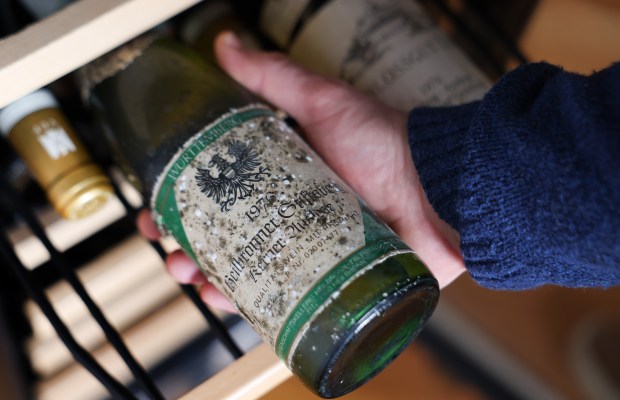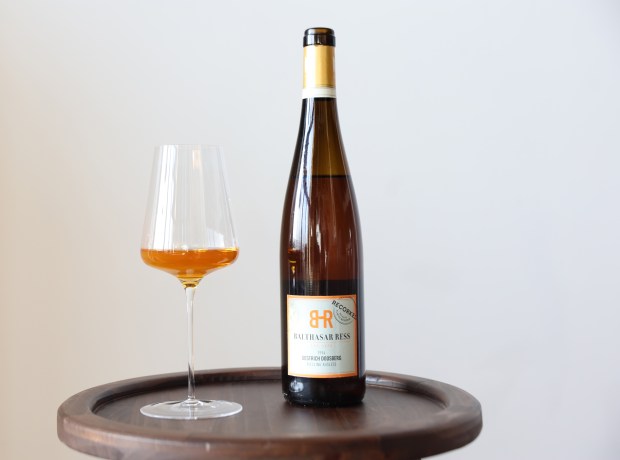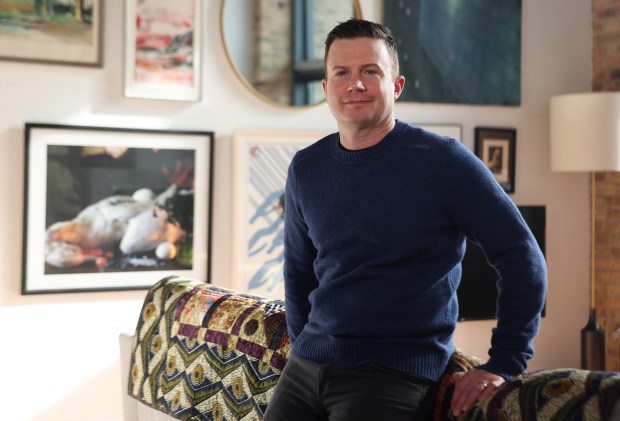In the years since my husband and I married, just a handful of mementos from our wedding day remain in our overcrowded city apartment. My wedding dress sits, sadly, crumpled in a garment bag at the back of my closet. A lone slice of cake lingers in the depths of the freezer and somewhere, there’s a video album no one has ever asked to watch.
As my 10th anniversary nears, however, there’s one keepsake I’m excited to revisit — a small collection of wines from the 2016 vintage, our wedding year. There’s nothing outrageously expensive or rare in my stash, just a few bottles of German riesling, some Champagne, Rhône reds and Burgundy. But they’re wines I love and know we’ll enjoy for anniversaries to come.
Wine is, after all, a wonderful and unique time capsule. Vintage bottles — wines produced from grapes harvested in a single year — capture the essence of a particular time and place. Setting aside a nice bottle, or seeking out and purchasing mature ones, can be a meaningful way to commemorate life’s big moments, whether the birth of a child, a wedding, graduation and beyond.
How to choose wines that improve with age
Almost any well-made wine can sustain itself for a few years after bottling. But not all wines get better with time.
“Say you’re a New Zealand sauvignon blanc drinker and your favorite wine is Kim Crawford,” suggests Alisha Blackwell-Calvert, an advanced sommelier and beverage director at the Italian restaurant Madrina in St. Louis. That specific style — wine designed to be fresh, fruity and easy to drink — isn’t built to improve over the long haul, she explains. “But take a white Bordeaux from France, made with the same grape by a top producer like Château Carbonnieux and age it for 10 years? It’s going to be beautiful,” she says.
To identify wines that are built to sustain and even improve for decades to come, it’s important to understand how wine is structured, says Jesse Becker, the master sommelier and Chicago-based U.S. sales manager for the import company Veritable Wines & Estates.
“For any wine that you drink, you want to start with high-quality fruit with an intensity of flavors,” explains Becker. For longer-term aging, however, you also want a high degree of structure — components such as acidity, tannins or residual sugar can help to preserve wine.
Bordeaux, for example, tannic, high-acid reds blended with cabernet sauvignon, merlot and cabernet franc, or high-acid white blends of sémillon and sauvignon blanc matured in wood barrels, have a historic track record of cellaring exceptionally well, explains Becker. So too does pinot noir and chardonnay from Burgundy, or syrah from the Northern Rhône in France. Germany is famous for the endurance of its high-acid rieslings. And Italy is a veritable treasure trove of structured reds, whether nebbiolo from Barolo or Barbaresco or sangiovese from Brunello di Montalcino and Chianti Classico.
Domestically, cabernet sauvignon from the Napa Valley or syrah from throughout California and Washington state are excellent contenders. Pinot noir from Oregon or riesling and cabernet franc from New York state mature beautifully too.
Beyond still wines, high-acid sparkling wines such as Champagne are long-lasting, as are fortified wines such as port or Madeira and high-quality sweet wines.
Don’t shy away from professional help
All of this may sound overwhelming, but it’s the kind of expertise that most knowledgeable wine professionals at fine-wine retailers are thrilled, even giddy, to share. After all, the best wines for aging aren’t always the rarest or most expensive, explains Blackwell-Calvert. A trusted wine professional, she suggests, is your best ally in guiding you toward age-worthy wines that align with your tastes, regardless of your budget, preferred vintage, wine style or region.
To track down older wines, Blackwell-Calvert looks to online retailers. Chambers Street Wines in New York is a favorite, she says, but you can also contact your favorite wineries directly to inquire about special releases of back vintages. And while most consumers assume that wine auctions deal exclusively with expensive Burgundy or Bordeaux, wine auctions, particularly online, offer older wines at surprisingly affordable prices, says Becker. Auction houses such as Sotheby’s, Christie’s or Acker Merrall & Condit are well known for wine, but “here in Chicago, we’re fortunate to have Hart Davis Hart, one of the premier auction houses in the United States,” he says. Hart Davis Hart also operates an online retail store with a wide selection of both current vintage and older wines.
Don’t buy what you won’t be able to store
Poor storage can ruin even the best wines. If you’re committed to cellaring wines at home for the long term, you’ll need a consistently cool, dark space that’s not too dry and that’s free of vibration, ideally a dedicated wine refrigerator, cellar or basement. The worst spot? “On top of your refrigerator,” says Blackwell-Calvert. “Not only does it vibrate, it’s also usually next to the stove and under the brightest lights in the house,” she says. For larger collections, consider off-site storage, says Becker. And if storage space is a challenge, consider buying wine that’s already mature.
What to expect from mature wines
While well-made wines stored in proper conditions can retain their distinctly primary, fruity flavors and bright color for nearly a decade, sometimes even longer, all wines evolve with time. As wines mature, their fresh-fruit flavors fade into dried or cooked fruit, and both red and white wines eventually adopt shades of brown, says Becker. For those accustomed to only young wines, this transformation can be an acquired taste. “At a certain point, it’s not really about the fruit anymore,” he explains, “but all these new aromas and flavors, complexities of fresh and dried herbs, roasted coffee, chocolate or spice even.”

“Over time, the wine will gain tertiary notes of earth and dust, leather and dried flowers,” adds Blackwell-Calvert, things that might not sound attractive, but have their own amazing beauty too.
Indeed, whether youthful or aged, a special bottle of wine can be a unique snapshot of our past. And like the milestones we celebrate, reminders of our own evolution and transformation too.
10 cellar-worthy wines, both current release and mature for inspiration
Château Carbonnieux Blanc 2023 ($35 at K&L Wine Merchants)
When looking for wines to cellar, “tune into the wines that you currently love to drink,” advises Blackwell-Calvert, but “invest more by looking to higher-end expressions from the best producers you can find from that region.” Blackwell-Calvert directs lovers of sauvignon blanc to Château Carbonnieux, one of Bordeaux’s oldest wine estates, known particularly for its white wine, a blend of sauvignon blanc and sémillon aged in barrels. Enjoyed young, it’s floral and citrusy, but with age, develops a textural richness and honeyed waxiness that’s sublime.
Catena Alta Malbec 2020 ($52 at Binny’s)
For lovers of Argentinian malbec, for instance, Blackwell-Calvert points to top producers such as Catena Zapata or Achaval Ferrer. Catena’s superb flagship bottlings cost over $100 on release, but this midlevel Alta is an affordably priced but elegant malbec with the persistence and structure to improve well beyond a decade.
Badia a Coltibuono 2019 Chianti Classico Riserva ($40 at wine.com)
Chianti Classico Riserva, made primarily from sangiovese grapes, represents the pinnacle of wines from Chianti in Italy’s Tuscany region, explains Blackwell-Calvert. It’s delightfully spry and blackberried in youth with bright acidity and sharp, angular tannins that provide enough backbone for it to develop its distinctly truffled, floral perfume with age.
Lionel Faury 2021 Côte-Rôtie ($60 at Binny’s Beverage Depot)
Asked to recommend a few age-worthy selections, Becker suggests this small-production syrah from Lionel Faury, the newest generation at the helm of the historic Domaine Faury in the Northern Rhône’s Côte-Rôtie region. Enjoyed young, it’s a penetrating wine packed with vibrant cassis and cherry flavors but develops haunting complexities of black olive and charred meat, tar and violet perfume as it matures.
Balthasar Ress 1994 Oestrich Doosberg Auslese Riesling “Recorked” ($90 at Veritable Wines & Estates)
Many wineries have extensive libraries of back-vintage wines that are released periodically through their distributors, Becker says. At Veritable Wines & Estates, Becker is currently featuring a range of wines from 1989 to 2005 by Balthasar Ress, a historic producer of riesling from the Rheingau region of Germany. Particularly older vintages have been recorked at the winery to maintain their condition. The wines, ranging from $50-$300, can be specially sourced from retailers through Veritable Wines & Estates.

Warre’s 1985 Vintage Port ($80 at K&L Wine Merchants)
Port, the famed fortified wines of the Douro region in Portugal, are wildly undervalued even for mature bottles. Bottlings with vintage-specific labels in port indicate a vintage that was officially declared as excellent. 1985 was a particularly well-received vintage and at 40 years of age, this bottle would be a sublime anniversary bottle.
Heitz Cellar 2018 Napa Valley Cabernet Sauvignon ($65 at Vin Chicago)
Increasingly rare in Napa, Heitz offers excellent midpriced options in wide distribution that share the kind of vitality and finesse that made their flagship single-vineyard wines cult favorites. At $65, this bottling won’t be a weekday pick, but is likely to have the intensity and structure to age beautifully for at least two decades.
G.D. Vajra 2020 Coste di Rose Barolo ($69 at Hart Davis Hart)
Barolo, Barbaresco and Brunello di Montalcino are known as the “Killer B’s,” the titan wines of Italy notable for their longevity and grace, explains Becker. Barolo, the legendary nebbiolos from Piedmont, with their intense tannins and slow-opening nature, beg for time in the cellar. Becker suggests this current-release bottling from G.D. Vajra, a leader in organic viticulture in Barolo, as a cellar selection well worth waiting for.
Domaine de la Pépière 2022 Muscadet Cru Clisson ($32 at Chambers Street Wines)
For both value and endurance, few white wines can rival the aging power of muscadet, the bracingly high-acid, saline wines of the Loire Valley in France. Enjoyed young, muscadet is a classic thirst quencher paired with oysters and other seafood. After a decade (or three) in the cellar, they transform texturally, adopting a richness and viscosity that can be thrilling.
Charles Heidsieck 2013 Vintage Brut Millésimé ($150 at wine.com)
Blackwell-Calvert, a self-declared “Champagne fanatic,” happened upon a 1996 bottle of Charles Heidsieck’s benchmark Blanc des Millénaires bottling at a cut-rate price during the pandemic. “I’d never had Champagne that old but I took it home and it was indescribably exquisite,” she says. Like port, Champagne houses indicate vintages only in excellent years. While certainly not a bargain, the Brut Millésimé bottling from Charles Heidsieck puts well-aged Champagne within reasonable reach.
Anna Lee Iijima is a freelance writer.



